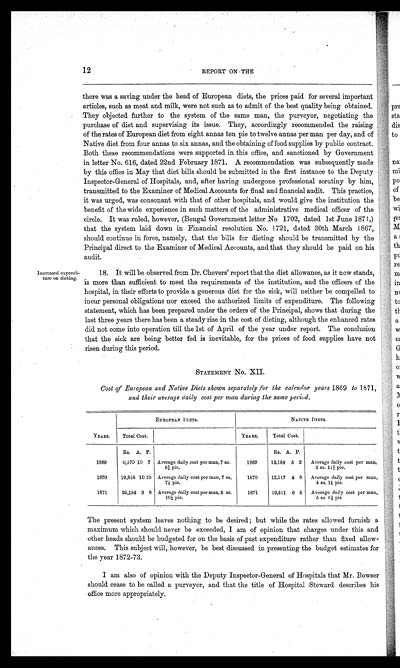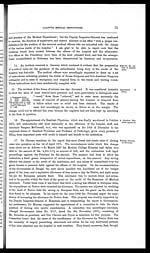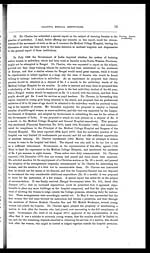Medicine - Institutions > Reports from medical colleges, schools and research institutions > Report on the Calcutta medical institutions > Calcutta medical institutions reports 1871-78 > Report on the Calcutta Medical Institutions for the year 1871
(22) Page 12
Download files
Individual page:
Thumbnail gallery: Grid view | List view

12
REPORT ON -THE
there was a saving under the head of European diets, the prices paid for several important
articles, such as meat and milk, were not such as to admit of the best quality being obtained.
They objected further to the system of the same man, the purveyor, negotiating the
purchase of diet and supervising its issue. They, accordingly recommended the raising
of the rates of European diet from eight annas ten pie to twelve annas per man per day, and of
Native diet from four annas to six annas, and the obtaining of food supplies by public contract.
Both these recommendations were supported in this office, and sanctioned by Government
in letter No. 616, dated 22nd February 1871. A recommendation was subsequently made
by this office in May that diet bills should be submitted in the first instance to the Deputy
Inspector-General of Hospitals, and, after having undergone professional scrutiny by him,
transmitted to the Examiner of Medical Accounts for final and financial audit. This practice,
it was urged, was consonant with that of other hospitals, and would give the institution the
benefit of the wide experience in such matters of the administrative medical officer of the
circle. It was ruled, however, (Bengal Government letter No 1702, dated 1st June 1871,)
that the system laid down in Financial resolution No. 1721, dated 30th March 1867,
should continue in force, namely, that the bills for dieting should be transmitted by the
Principal direct to the Examiner of Medical Accounts, and that they should be paid on his
audit.
Increased expendi-
ture on dieting
18. It will be observed from Dr. Chevers' report that the diet allowance, as it now stands,
is more than sufficient to meet the requirements of the institution, and the officers of the
hospital, in their efforts to provide a generous diet for the sick, will neither be compelled to
incur personal obligations nor exceed the authorized limits of expenditure. The following
statement, which has been prepared under the orders of the Principal, shows that during the
last three years there has been a steady rise in the cost of dieting, although the enhanced rates
did not come into operation till the 1st of April of the year under report. The conclusion
that the sick are being better fed is inevitable, for the prices of food supplies have not
risen during this period.
STATEMENT No. XII.
Cost of European and Native Diets shown separately for the calendar years 1869 to 1871,
and their average daily cost per man during the same period.
| YEARS. | EUROPEAN DIETS. | NATIVE DIETS. | |||
| Total Cost. | YEARS. | Total Cost. | |||
| Rs. A. P. | Rs. A. P. | ||||
| 1869 | 0,370 10 7 | Average daily cost per man, 7 as. 5¾ pie. |
1869 | 12,159 5 2 | Average daily cost per man, 3 as. 11¾ pie. |
| 1870 | 19,848 10 10 | Average daily cost per man, 7 as. 7½ pie. |
1870 | 12,117 4 6 | Average daily cost per man, 4 as. 1½ pie. |
| 1871 | 25,154 3 9 | Average daily cost per man, 8 as. 10¼ pie. |
1871 | 16,511 6 5 | Average daily cost per man, 5 as. 6⅛pie |
The present system leaves nothing to be desired; but while the rates allowed furnish a
maximum which should never be exceeded, I am of opinion that charges under this and
other heads should be budgeted for on the basis of past expenditure rather than fixed allow-
ances. This subject will, however, be best discussed in presenting the budget estimates for
the year 1872-73.
I am also of opinion with the Deputy Inspector-General of Hospitals that Mr. Bowser
should cease to be called a purveyor, and that the title of Hospital Steward describes his
office more appropriately.
Set display mode to: Large image | Zoom image | Transcription
Images and transcriptions on this page, including medium image downloads, may be used under the Creative Commons Attribution 4.0 International Licence unless otherwise stated. ![]()
| Permanent URL | https://digital.nls.uk/74972668 |
|---|
| Description | 13 titles. Describes research work and conditions, treatments, vaccine production, medical education, public health and disease outbreaks. Extensive tables show mortality rates and patient admissions. These - some from asylums, jails, dispensaries, civil and police hospitals – will be useful to epidemiologists. |
|---|




